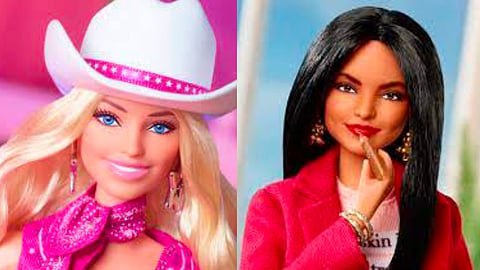
- HOMEGROWN WORLD
- #HGCREATORS
- #HGEXPLORE
- #HGVOICES
- #HGSHOP
- CAREERS
- ABOUT US
- CONTACT US

The marketing that the upcoming movie Barbie (2023), directed by Greta Gerwig and starring Margot Robbie and Ryan Gosling, has received over the past year is unparalleled, to say the least. Nearly no other movie has come close.
There are many aspects to consider when trying to unpack how this movie managed to capture the attention of so many people. Could it be attributed solely to the relentless marketing efforts of the Barbie team, particularly the ultimate Barbie vs Oppenheimer showdown? Or is it the anticipation of what filmmaker Greta Gerwig brings to the film?
Perhaps, it's simply the pink-ness of it all.
Beyond these questions, what intrigues us more is the legacy that Barbie has established in India. The journey for Barbie in India has not been smooth, in fact, its reception in India has been complex, struggling to conquer the market and establish name recognition.
Barbie was first introduced in India in 1982 as the standard American doll, which didn't resonate well with the Indian audience. The American Barbie, with her blonde hair and blue eyes, didn't seem to fit in with the Indian cultural landscape. Only later when Barbie appeared in a sari, reflecting Indian culture and advertising practices employed which were specific to India, did sales improve. In 1991, after the American Barbie failed to sell satisfactorily in India, the Indian-inspired Barbie emerged, featuring a sari, bangles, bindi, and black hair.
Among the Indian Barbie dolls, the most expensive ones are part of the Collector and Glamour collections. These Barbies depict ethnic and regional diversity and are often sold in high-end places like five-star hotels, airports, and tourist areas. They serve more as souvenirs for tourists in India, rather than being targeted towards the Indian consumers due to their high prices. As a kid, I remember wanting the American Barbies over the Indian Barbies, because they were the staple birthday gifts for prepubescent girls.
Over the years, there have been several Indian editions of Barbie, some more prominent than others. Examples include the 'Dolls of the World - India' collection and the 'Bollywood Barbie' collection, which draws inspiration from the world of Bollywood cinema. The 'Festivals of India Barbie' collection pays tribute to Indian festivals, with each doll representing a specific festival.
Despite Barbie's attempts to adapt to Indian culture by wearing Indian clothes and accessories, she never achieved the same level of popularity in India as she did in other countries. This can be attributed to Indian cultural norms that reject overly sexualized and ethnocentric Western portrayals of women's bodies.
As a cultural icon, Barbie consistently enters the realm of public discussion and scrutiny with each new appearance, prompting critics to question the portrayal of a barbie doll that doesn't accurately represent "the real woman". Barbie has also faced criticism for promoting unrealistic body image ideals and reinforcing Western cultural values.
However, what Barbie did manage to do was introduce young Indian women to a variety of fashion choices, shaping their social interactions, definitions of glamour, and aspirations for the future. Efforts have been made to address the many concerns, including the rise of Indian-made Barbie dolls like Kiyaa, designed to be more culturally appropriate and promote positive body image ideals. Barbie had also released a doll modelled after Indian gymnast Dipa Karmakar, showcasing its commitment to diversity. However, the availability and affordability of these dolls remain limited in India.
Since her birth in 1959, Barbara Millicent Roberts, better known as the first Barbie, has undergone many transformations. Just like her, Barbie's image and what she stands for is continuously evolving, and it does not represent traditional feminine activities like it once did. What Barbie aims to do now is stay relevant and true to its original purpose of inspiring the limitless potential in every girl.
